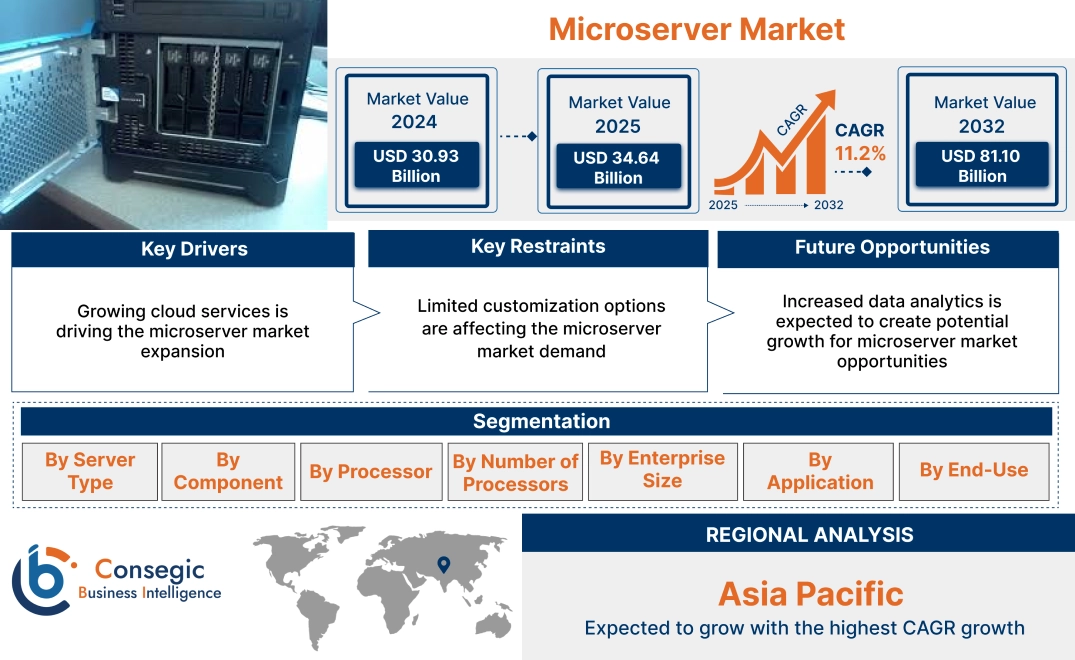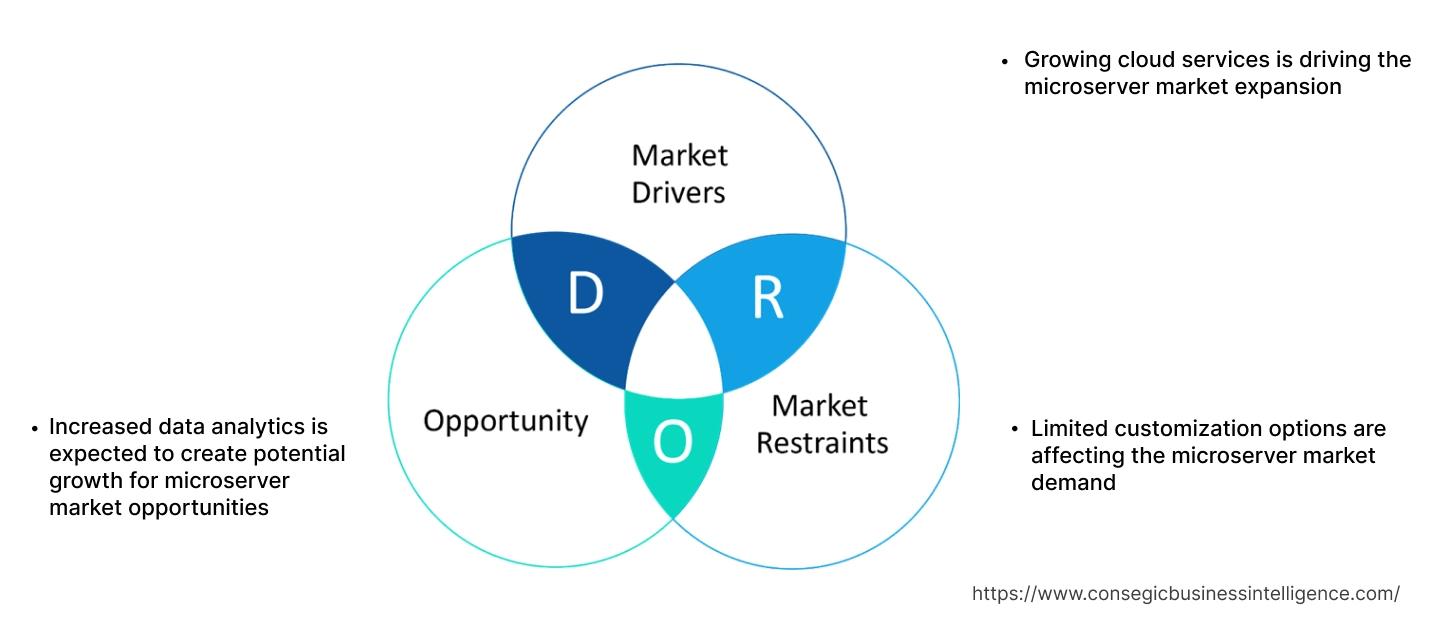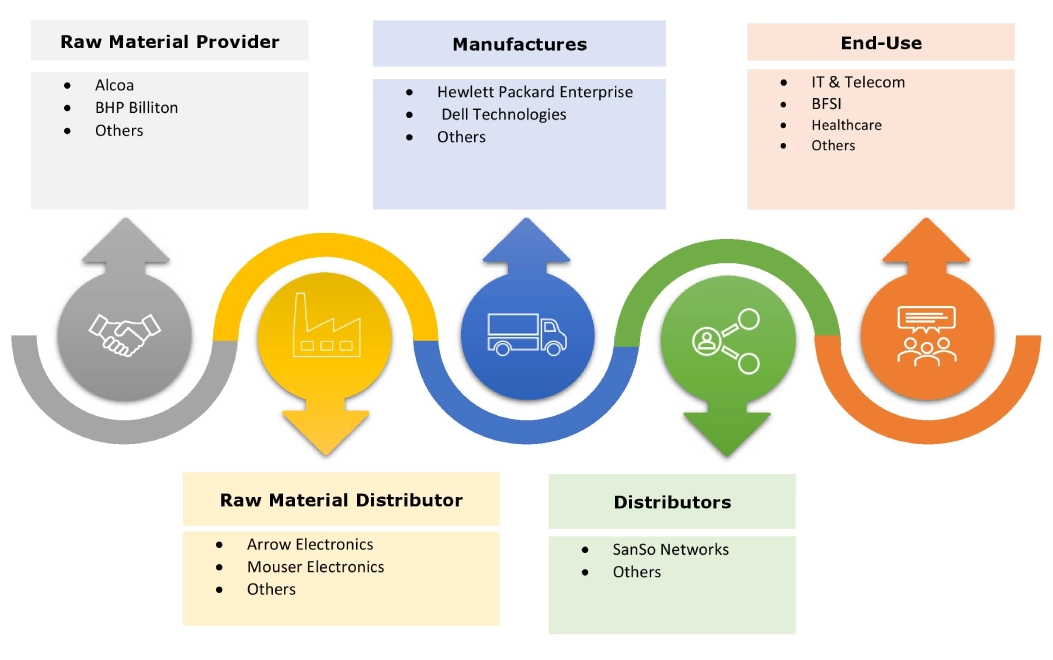- Summary
- Table Of Content
- Methodology
Microserver Market Size:
Microserver Market Size is estimated to reach over USD 81.10 Billion by 2032 from a value of USD 30.93 Billion in 2024 and is projected to grow by USD 34.64 Billion in 2025, growing at a CAGR of 11.2% from 2025 to 2032.
Microserver Market Scope & Overview:
Microserver is built to manage workloads that don't require the high processing power of conventional servers, making them suitable for tasks like web hosting, caching, and basic data analytics. These servers usually utilize low-power processors such as ARM or Intel Atom, consuming less energy and producing less heat than larger models. A major factor driving the global market is the rising demand for energy-efficient data center solutions. As organizations aim to cut operational costs and lessen their carbon footprint, these servers present an attractive alternative to traditional server architectures. Their capacity to consolidate workloads onto smaller, more efficient platforms aligns well with the developments of cloud computing and edge computing, where localized data processing is increasingly important.
Key Drivers:
Growing cloud services is driving the microserver market expansion
The rise of cloud services has significantly transformed the global IT landscape, affecting how businesses and consumers access and utilize computing resources. Cloud services include various offerings such as infrastructure-as-a-service (IaaS), platform-as-a-service (PaaS), and software-as-a-service (SaaS), provided over the internet by cloud providers. These services allow organizations to minimize capital expenditure on IT infrastructure by adopting a pay-as-you-go model, where resources are leased instead of owned. This flexibility is specifically advantageous for businesses of all proportions, enabling them to adjust their operations seamlessly based on demand fluctuations. These servers are essential in supporting cloud services, offering cost-effective and energy-efficient computing solutions ideal for lightweight tasks and distributed computing environments.
Additionally, the development of data-intensive applications like big data analytics, artificial intelligence (AI), and machine learning (ML) has further increased the demand for cloud services. These applications require substantial computing power and storage, which cloud providers fulfill efficiently through data centers equipped with micro servers.
- For instance, in December 2024, Amazon unveiled new data centers servers packed with its own AI chips. These servers utilize 64 of Amazon Web Services Trainium2 chips, which will be interconnected to form a massive supercomputer featuring hundreds of thousands of chips, in collaboration with AI startup Anthropic. These new solutions are specifically designed for the intensive workloads required by advanced generation AI training and inference.
Thus, according to the microserver market analysis, the growing cloud services is driving the microserver market size.
Key Restraints:
Limited customization options are affecting the microserver market demand
Micro servers are compact, energy-efficient systems designed for lightweight computing tasks, making them suitable for applications that do not need the full capabilities of traditional servers. They are especially popular in data centers for web hosting, cloud computing, and content delivery, where their small sizing and low power consumption lead to reduced operational costs and enhanced scalability.
Moreover, the increasing use of cloud services and the growth of IoT devices have further driven the need for micro servers, as they provide a scalable and flexible infrastructure solution. However, despite their benefits, micro servers encounter challenges such as limited customization options compared to larger server architectures. This constraint can limit their use in certain specialized computing tasks that require highly customized hardware configurations or substantial processing power. Thus, the availability of limited customization option is restraining the micro server market growth.
Future Opportunities :
Increased data analytics is expected to create potential growth for microserver market opportunities
Micro servers are small, energy-efficient servers designed for lightweight tasks like basic data processing and content delivery. As the volume of data generated by connected devices, IoT systems, and digital platforms continues to increase, there is a growing need for effective data processing solutions. Micro servers cater to this need by providing scalability and cost-effectiveness, making them suitable for organizations that need to manage large data volumes without the expense of traditional larger servers.
Further, the rise of cloud and edge computing applications has further increased the need for micro servers. These servers are particularly advantageous in edge environments where space and power are limited. They allow for faster data processing closer to the source, improving real-time analytics and reducing latency. As businesses depend more on data-driven insights for competitive advantages and operational efficiencies, the global market is set for ongoing developments. Major players are innovating to boost performance, enhance energy efficiency, and incorporate advanced analytics into their micro server solutions, addressing the changing requirement of modern businesses in a data-driven landscape.
- For instance, in February 2023, Supermicro has teamed up with Rakuten Symphony to create next-generation servers for cloud and mobile services, highlighting the increasing importance of these servers in scalable, high-performance computing. As a key partner with Rakuten Symphony, the two companies are offering operators blueprints for cloud-based mobile services that leverage cutting-edge servers and networking architecture, providing a straightforward implementation solution for operators globally. Furthermore, Rakuten Symphony can rapidly provide Open RAN solutions along with prompt technical support and consulting services.
Thus, based on the above analysis, growing data analytics is driving the microserver market opportunities.
Microserver Market Segmental Analysis :
By Server Type:
Based on server type, the market is segmented into tower, rack, and blade.
Trends in the server type:
- The growth of edge computing is increasing the need for micro servers, which are well-suited for use in remote areas.
- Micro servers offer a budget-friendly option for small businesses and organizations with restricted IT resources.
- Micro servers are becoming denser, incorporating greater processing power and memory into a compact form. This is fuelled by advancements in processor and memory technologies, along with the need to minimize data center space.
- These factors, analysis, and advancements in server technology would further create the microserver market demand during the forecast period.
The rack segment accounted for the largest share of 42.78% in the year 2024 and it is expected to register the highest CAGR during the forecast period.
- Rack servers are designed to accommodate a wide variety of needs and are installed individually in a rack, making their construction and design suitable for both high and low computing demands.
- The segmental growth is propelled by the increasing need for scalable data centers, high-density computing, and progressions in technologies including cloud computing, IoT, and edge computing, in turn presenting substantial prospects for market participants.
- Rack servers facilitate computing and data storage at a lower cost, enabling companies to set up servers for their private use.
- For instance, in June 2024, Supermicro launched X14 AI, multi-node, rack server, and edge server, based on Xeon 6 processors. The new Supermicro X14 servers are compatible with the new Intel Xeon 6 processors, offering a range of rackmount servers designed for enterprise use, cloud service providers, entry-level models and mid-range, including the WIO platforms Hyper and CloudDC.
- These advancements in rack server segment would further drive the microserver market size and industry during the forecast period.
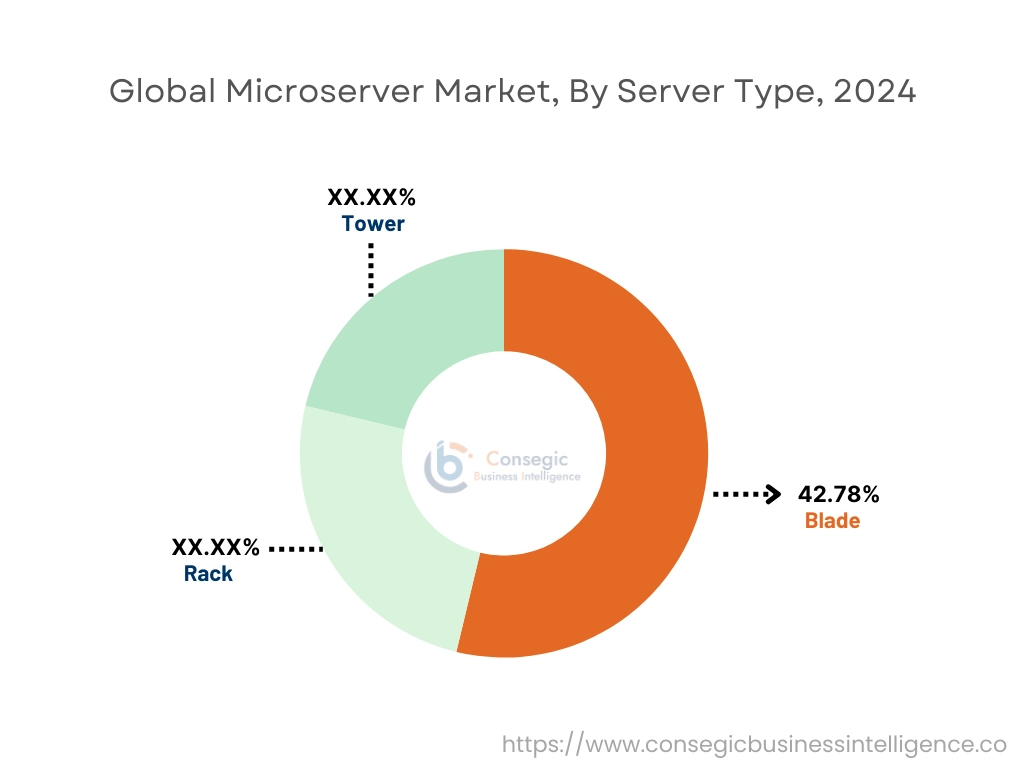
By Component:
Based on component, the market is segmented into hardware, software, and services.
Trends in component:
- These servers are increasingly powerful, accommodating the latest processors, memory, and storage technologies to manage workloads.
- They provide a cost-effective option for small businesses and organizations with limited IT budgets, compared to traditional servers.
- Thus, based on the above factors and analysis, the growing need for effective processors would further drive the market during the forecast period.
The hardware segment accounted for the largest revenue in the year 2024.
- Micro servers employ different storage solutions, such as hard disk drives (HDDs), solid-state drives (SSDs), or a mix of both. The selection of storage is based on the specific application needs, focusing on capacity, performance, and reliability.
- These servers are more compact, incorporating increased processing power and memory in a smaller sizing. This enhances the efficiency of data center space utilization and lowers the total cost of ownership.
- These servers come with network interfaces to link with other devices and networks. This enables them to communicate with clients, retrieve data from other servers, and engage in distributed computing environments.
- Therefore, the need for high performance infrastructure is reinforcing the necessity for better hardware, in turn driving the microserver market growth.
The service segment is anticipated to register the fastest CAGR during the forecast period.
- The continuous digital transformation of businesses and industries is fuelling the need for server-based services.
- The rising volume of data produced by multiple sources necessitates efficient processing and storage solutions, which these servers can offer.
- Their flexibility, scalability, and cost-effectiveness makes them a valuable asset in the contemporary computing environment.
- As technology progresses, these servers are anticipated to provide innovative services and solutions.
By Processor:
Based on the processor, the market is segmented into Intel, AMD, and ARM.
Trends in the processor:
- ARM architecture has emerged as a significant player in server market. Its natural power efficiency and cost-effectiveness make it suitable for a variety of server workloads, especially in edge computing and scale-out deployments.
- SoCs combine multiple components onto the processor die, which further lowers power consumption, footprint, and cost, which is increasing in global market.
- Processors are increasingly embedding security features such as secure boot, memory encryption, and others to safeguard sensitive data.
- Thus, growing need for enhanced security features would further supplement the microserver market trends during the forecast period.
The Intel segment accounted for the largest revenue in the year 2024 and it is expected to register the highest CAGR during the forecast period.
- Intel processors lead the market due to their established reputation for providing high-performance and reliable solutions. They are extensively used across diverse applications, ranging from enterprise servers to data centers, with their exceptional performance and robust support ecosystem.
- Ongoing innovation, exemplified by the release of new generations of Xeon processors, helps maintain their edge in processing power, energy efficiency, and integrated features. Intel's strong partnerships with major OEMs and its extensive product portfolio reinforce its dominant position in the market.
- For instance, in June 2024, Intel launched its next-generation server processors. Achieving the same computing power as its second-generation chips will require approximately 67% fewer server racks using the efficiency model, which is intended for media serving, website operations, and database calculations.
- These factors and developments would further drive the microserver market share during the forecast period.
By Number of Processors:
Based on the number of processors, the microserver market is segmented into 1-2, 2 or 4 and upto 8.
Trends in the number of processors:
- As edge computing becomes increasingly common, these servers are utilized in settings that need more sophisticated tasks such as AI inference, real-time data processing, and local storage. This frequently necessitates the use of multiple processors.
- Specific applications, including video transcoding, database processing, and AI training, gain considerable advantages from the parallel operation of multiple processors. These servers with a greater number of processors can be customized for these specialized tasks.
- Thus, growing edge computing needs would further supplement the global market during the forecast period.
The 2 to 4 segment accounted for the largest revenue in the year 2024 and it is expected to register the highest CAGR during the forecast period.
- Dual-processor micro servers typically achieve an optimal balance between performance and power consumption. They offer a noticeable increase in processing power over single-processor systems while still achieving satisfactory energy efficiency.
- These dual-processor setups are ideal for various general-purpose tasks, such as web hosting, application serving, and database processing.
- Many edge applications, like industrial automation and autonomous vehicles, necessitate real-time data processing. These servers with multiple processors can fulfill these performance standards.
- For instance, Fujitsu’s PRIMERGY RX770 M7 server with 2 to 4 processors handles large data sets with up to 48 DDR5 DIMMs, supporting speeds of up to 4800 MT/s. Additionally, it is well-suited for business-critical workloads, extensive virtualization, and in-memory databases.
- As technology progresses, further innovations in micro servers processor configurations are expected to address the changing requirements of contemporary computing.
By Enterprise Size:
Based on enterprise size, the market is segmented into large and small & medium.
Trends in enterprise size:
- Enterprises are utilizing these servers for targeted tasks such as video transcoding, AI inference, or data analytics, often alongside larger server systems.
- The transition to edge computing is a significant factor driving the market. Enterprises require data to be processed nearer to its source, and these servers provide the essential computing power and connectivity needed for this.
- As companies embrace hybrid cloud strategies, these servers can be pivotal in linking on-premises infrastructure with cloud resources, facilitating smooth data flow and application delivery.
- Thus, based on the above factors and analysis, the growing digital transformation initiatives and increasing data volumes would further drive the market during the forecast period.
The large enterprise segment accounted for the largest revenue share in the year 2024.
- Large enterprises are increasingly prioritizing hosted application servers due to their ability to manage workloads from multiple locations, often utilizing the same database.
- The deployment of hosted application servers is easier than that of traditional application servers, as it eliminates the need for initial installations and minimizes system integrations, thereby lowering operational and maintenance expenses. A hosted application server is entirely managed by a service provider who routinely updates the system and provides ongoing technical and customer support.
- Market players are concentrating on introducing industry-specific solutions to appeal to potential business clients and boost their market revenue.
- For instance, in May 2022, Nokia Corporation launched the Nokia Cloud Native Communication Suite, specifically created for 4G, 5G, and Wi-Fi deployments. The solution includes a Media Resource Function (MRF), Telephony Application Server (TAS), and Cloud Native Network Function (CNF), among others.
- These factors and developments in large enterprise segment would further drive the global market during the forecast period.
The small & medium segment is anticipated to register the fastest CAGR during the forecast period.
- The rising need for servers among medium enterprises is driven by the increasing adoption of cloud services, the necessity for environmentally friendly data centers, and the integration of complex business tools like big data and data analytics.
- Additionally, private cloud server solutions can improve business processes for medium enterprises. A private cloud server provides advantages such as reduced operational costs, pay-per-use options, and customized offerings to meet specific business needs.
- Various market players offer scalable infrastructure and cost-effective services that are well-suited for medium enterprises, which is likely to promote the adoption of private cloud deployment.
- Moreover, private cloud server solutions allow medium enterprises to benefit from 24/7 support while eliminating the need for dedicated IT staff.
- These advantages are anticipated to further drive the need for servers in small and medium enterprises throughout the forecast period.
By Application:
Based on the application, the market is segmented into data center, cloud computing, media storage, data analytics, content delivery, others.
Trends in the application:
- The growing dependence on cloud services is fuelling the need for affordable and scalable infrastructure, making micro servers a desirable choice.
- As energy costs rise and environmental concerns increase, the energy efficiency of these servers significantly contributes to their adoption.
- Thus, increasing need for energy efficiency and development of cloud computing would further supplement the microserver market trends during the forecast period.
The cloud computing segment accounted for the largest revenue share in the year 2024 and it is expected to register the highest CAGR during the forecast period.
- Cloud computing requires the capability to scale resources easily based on requirements. These servers with their modular design, facilitate fine-tuned scaling, optimizing both resource allocation and cost efficiency.
- The growing dependence on cloud-based applications, storage, and services significantly drives the adoption of such type of servers. Cloud providers need affordable and scalable infrastructure to accommodate increasing need and meet this need effectively.
- These servers are particularly well-suited for edge computing environments due to their compact dimension, energy efficiency, and sufficient processing power.
- Sectors such as healthcare, automotive, and smart cities are increasingly integrating edge computing to improve operational efficiency and support advanced applications like autonomous driving and real-time analytics.
- For instance, in February 2025, Google announced the investment of USD 75 billion to expand its AI and cloud capacity. Google will allocate most of its increasing capital expenditures to alleviating capacity constraints by upgrading its infrastructure, such as cloud servers and data centers.
- Thus, on the factors and analysis, it would further drive the market during the forecast period.
By End Use:
Based on end use, the microserver market is segmented into IT & telecom, BFSI, government & defense, healthcare, retail, and others.
Trends in the end use:
- Micro servers are ideal for particular tasks and workloads, including web serving, caching, and data analytics. This characteristic appeals to organizations with varied computing requirements, enabling them to optimize their infrastructure for multiple applications.
- These servers find use in several areas, such as data storage, network management, and application hosting. The scalability of these servers enables enterprises to grow their IT infrastructure to meet increasing business needs without significant expenses.
- As companies increasingly digitalize and utilize big data, their dependence on effective server solutions ensures the large IT & telecom organizations market dominance.
The IT & telecom segment accounted for the largest revenue share in the year 2024 and it is expected to register the highest CAGR during the forecast period.
- The growing amount of data generated by applications, devices, and users is creating a strong need for scalable and efficient computing infrastructure. Micro servers present a cost-effective solution for managing this data surge.
- The necessity of processing data closer to its origin is propelling the development of edge computing in both IT and telecom industries. The compact dimension and low power consumption of these servers make them well-suited for deployment in edge environments.
- Organizations in various sectors are embracing digital transformation, increasingly depending on IT and telecom infrastructure to support their operations. Micro servers offer a flexible and scalable solution to address the changing needs of digital businesses.
- For instance, in November 2023, Hewlett Packard Enterprise (HPE) announced partnership with NVIDIA to launch a robust GenAI solution for businesses. This partnership seeks to combine NVIDIA's cutting-edge GPU technology with HPE's infrastructure knowledge and microservers, providing high-performance computing solutions tailored for AI tasks.
- These advancements in IT & telecom segment would further drive the market during the forecast period.
Regional Analysis:
The global market has been classified by region into North America, Europe, Asia-Pacific, MEA, and Latin America.

Asia Pacific microserver market expansion is estimated to reach over USD 25.14 billion by 2032 from a value of USD 8.92 billion in 2024 and is projected to grow by USD 10.05 billion in 2025. Out of this, the China market accounted for the maximum revenue split of 32.90%. Countries in this region are undergoing significant digital transformation, driven by factors such as urbanization, increased internet penetration, and the growing adoption of smartphones. This has led to a rising need for data center infrastructure and cloud services, including server solutions. Additionally, government initiatives aimed at enhancing digitalization and improving internet connectivity further stimulate the need for servers in Asia Pacific. For example, programs like India's Digital India initiative and China's Made in China 2025 strategy are driving investments in cloud infrastructure and data centers. Furthermore, Asia Pacific boasts a thriving startup ecosystem, particularly in nations like India and Singapore, where startups often emphasize cloud-native architectures and scalable computing solutions, thereby boosting the adoption of servers in the region. These factors and analysis would further drive the regional microserver market growth during the forecast period.
- For instance, in January 2025, Reliance Industries announced that the company will build largest data center in Jamnagar, Gujarat. This project represents a crucial milestone in Reliance's foray into India's artificial intelligence (AI) sector. The project announcement was done after the Nvidia AI Summit held in October 2024, where both companies disclosed their intention to partner on AI infrastructure in India.
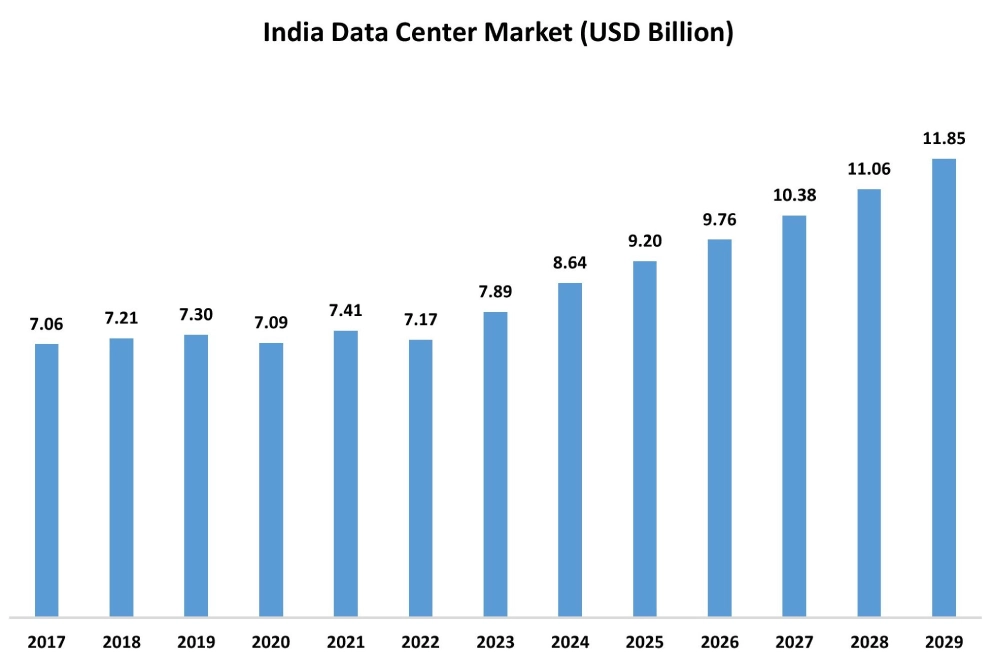
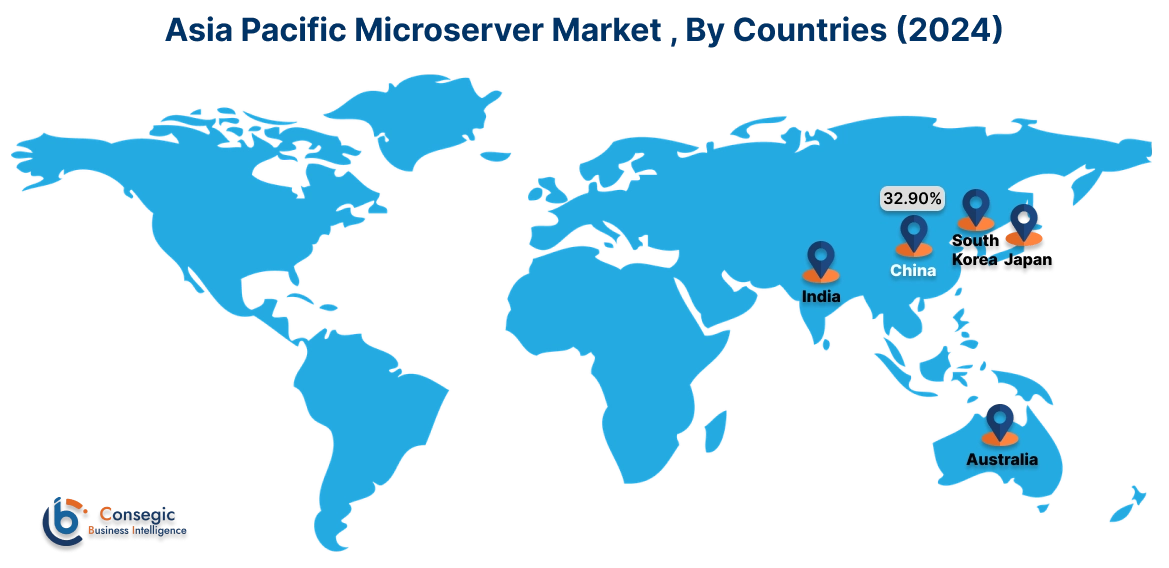
North America market is estimated to reach over USD 27.67 billion by 2032 from a value of USD 10.67 billion in 2024 and is projected to grow by USD 11.94 billion in 2025. North America occupied a significant position in the market in 2023, influenced by the presence of major technology firms, sophisticated IT infrastructure, and a strong focus on innovation. The region's substantial requirement for high-performance computing solutions across multiple industries, such as IT, telecommunications, and finance, drives the market. Moreover, the swift uptake of cloud computing and edge computing technologies enhances the requirement for micro servers. The U.S., particularly, is crucial because of its extensive network of data centers and tech giants making substantial investments in advanced server technologies. These factors and developments would further drive the regional microserver market share during the forecast period.
- For instance, in March 2024, NVIDIA introduced the NVIDIA Blackwell platform, allowing global organizations to develop and deploy real-time generative AI using trillion-parameter large language models, achieving significant reductions in costs and energy consumption compared to previous technologies. The Blackwell GPU architecture incorporates six advanced technologies for enhanced computing. These innovations are anticipated to foster significant advancements across various industries, including data processing, engineering simulation, electronic design automation, computer-aided drug design, quantum computing, and generative AI. These areas represent emerging sectors that provide new prospects for NVIDIA's progress. In addition to this, the technology will be adopted by server manufacturers, cloud providers, and leading AI companies.
According to the microserver industry, the European market has seen robust progression in the recent years. The region's focus on energy efficiency and sustainability promotes the adoption of micro servers, recognized for their low power consumption and compact design. Major industries like automotive, healthcare, and manufacturing are increasingly implementing micro server solutions to improve operational efficiency and advance digital transformation efforts. Moreover, the development of data centers and the expansion of cloud services in Europe are driving the increased need for servers.
Additionally, the number of internet users in Latin America has grown substantially in recent years, resulting in a rise in data traffic. This has generated a need for additional data centers to store and process this information, thereby increasing the need for servers. Additionally, as cyberattacks become more frequent, businesses and organizations in Latin America are prioritizing security. Microservers provide various security features, such as secure boots and hardware-based encryption, making them an appealing choice for many organizations. Furthermore, MEA countries are swiftly embracing digital transformation, with significant investments in IT infrastructure from both governments and businesses. This shift is fueling the need for microservers, which are ideal for facilitating various digital initiatives, including e-government services, online education, and e-commerce. Additionally, virtualization and containerization technologies are gaining traction in MEA, enabling businesses and organizations to run multiple applications on a single server. Microservers are particularly advantageous for these technologies, as they can be easily partitioned and assigned to different applications. Thus, based on the above microserver market analysis, these factors would further drive the regional market during the forecast period.
Top Key Players and Market Share Insights:
The global microserver market is highly competitive with major players providing services to the national and international markets. Key players are adopting several strategies in research and development (R&D), product innovation, and end-user launches to hold a strong position in the market. Key players in the microserver industry include-
- Hewlett Packard Enterprise (U.S.)
- Dell Technologies (U.S.)
- IBM Corporation (U.S.)
- Huawei (China)
- Intel Corporation (U.S.)
- Fujitsu Ltd (Japan)
- Quanta Computer Inc. (Taiwan)
- Super Micro Computer, Inc. (U.S.)
- ARM Holdings (U.K.)
- Cisco Systems, Inc. (U.S.)
Recent Industry Developments :
Product Launch:
- In November 2022, Hewlett Packard Enterprise (HPE) has launched a new generation of ProLiant servers. These servers are equipped with the latest EPYC family of CPUs and Altra processors, featuring over 96 CPU cores and supporting more than 6TB of DDR5 RAM. They are designed to address demanding workloads for AI and software-defined computing. Additionally, the new ProLiant servers offer GPU capabilities, high I/O bandwidth, and dense CPU cores.
Microserver Market Report Insights :
| Report Attributes | Report Details |
| Study Timeline | 2019-2032 |
| Market Size in 2032 | USD 81.10 Billion |
| CAGR (2025-2032) | 11.2% |
| By Server Type |
|
| By Component |
|
| By Processor |
|
| By Number of Processors |
|
| By Enterprise Size |
|
| By Application |
|
| By End Use |
|
| By Region |
|
| Key Players |
|
| North America | U.S. Canada Mexico |
| Europe | U.K. Germany France Spain Italy Russia Benelux Rest of Europe |
| APAC | China South Korea Japan India Australia ASEAN Rest of Asia-Pacific |
| Middle East and Africa | GCC Turkey South Africa Rest of MEA |
| LATAM | Brazil Argentina Chile Rest of LATAM |
| Report Coverage |
|
Key Questions Answered in the Report
How big is the Microserver market? +
Microserver Market Size is estimated to reach over USD 81.10 Billion by 2032 from a value of USD 30.93 Billion in 2024 and is projected to grow by USD 34.64 Billion in 2025, growing at a CAGR of 11.2% from 2025 to 2032.
Which is the fastest-growing region in the Microserver market? +
Asia-Pacific is the region experiencing the most rapid growth in the market.
What specific segmentation details are covered in the Microserver report? +
The microserver report includes specific segmentation details for server type, component, processor, number of processors, enterprise size, application, end use, and region.
Who are the major players in the Microserver market? +
The key participants in the market are Hewlett Packard Enterprise (U.S.), Dell Technologies (U.S.), Fujitsu Ltd (Japan), Quanta Computer Inc. (Taiwan), Super Micro Computer, Inc. (U.S.), ARM Holdings (U.K.), Cisco Systems, Inc. (U.S.), IBM Corporation (U.S.), Huawei (China), Intel Corporation (U.S.), and others.
